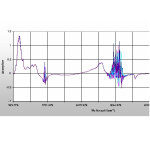Development of a new test method for the quality analysis of honey
Jointly financed by the European Union and the German federal states of Berlin, Brandenburg, Saxony-Anhalt, Saxony and Thuringia
Quality analysis of honey comprises a variety of chemical and physical analytical methods that are very costly due to the time involved, the high demand in chemicals and their disposal. Fourier transform infrared spectroscopy (FTIR) is already in use as a routine procedure in many areas of the food industry and offers the advantage of being a multi-component analysis.
What is FTIR? The principle of infrared measurement is based on the detection of different vibrations of atomic bonds caused by excitation with infrared light within a molecule. With the aid of a built-in interferometer and the mathematical method of the Fourier transform, one obtains an absorption spectrum in the mid-IR range (400-4000 cm-1) of the sample to be analysed. Since most molecules absorb in this wavelength range but each has a different structure, differences in the absorption maxima are the result.
All criteria to be examined can be determined in one measurement (about 2 minutes) with FTIR. This technology requires extensive calibrations in advance to prepare it for a routine analysis of honey. For this purpose, all calibration samples must first be examined using standard procedures in order for them to be used as reference samples during the calibration.
Initial results show that infrared spectroscopy is suitable as a fast and reliable method for honey. The content of the main sugars, electrical conductivity, pH value and free acids can already be reliably determined this way.
The aim is to combine the routine determination of important chemical and physical parameters with FTIR into one single work step, in order to make the analysis of honey more cost-effective for beekeepers and to achieve the production and marketing of high-quality honey.
- Authentication of honey from selected regions
- Sucrose degradation during the storage of honey: impact of time, temperature, enzyme activity and botanical origin
- Development of a new test method for the quality analysis of honey
- Influence of honey ingredients on the development of the bee
- Evidence for correlation between invertase activity and sucrose content during the ripening process of honey


